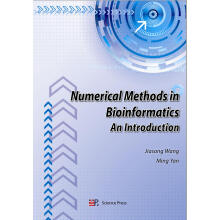PREFACE
CHAPTER 1 SOME BIOLOGICAL CONCEPTS
1.1 Cell
1.2 Genetic Material: DNA, Gene and RNA
1.2.1 DNA
1.2.2 Gene
1.2.3 RNA
1.3 Protein and Amino Acids
1.4 Chromosome
1.5 Omics
1.5.1 Genomics
1.5.2 Microarray
1.5.3 Proteomics
1.5.4 Lipidomics
REFERENCES
CHAPTER 2 GRAPHICAL REPRESENTATIONS OF DNA SEQUENCE
2.1 Three-Dimension (3-D) GraphicaIRepresentation
2.2 2-DGraphicalRepresentatio
2.3 2-D GraphicalRepresentations Without Degeneracy
2.4 Used a 1-D NumerioalRepresentation offourNucleotides to Construct a 2-D Graplucal Representation ofthe DNA Sequence
REFERENCES
CHAPTER 3 NUMERICAL REPRESENTATIONS OF DNA SEQUENCE
3.1 4-D and 3-D Numerical Representations of a DNA Sequence
3.2 2-D Numerical Representations of a DNA Sequence
3.3 The Complex NumericalRepresentation
3.4 1-D Numerical Representations of four Nucleotides and 2-D Graphical
Representation of a DNA Sequence
3.5 The Representations ofFeature Vector, Genome Space and Matrix Representation of DNA Sequence
3.6 The Numerical Representation Based on Physical, Chemical and Structural
Properties of DNA Sequence
3.6.1 The numericalrepresentations based on some attribute equivalences
ofnucleotides
3.6.2 The representation of DNA by the inspiration from codon and the idea ofthree attribute equivalences
3.6.3 EIIPnumericalrepresentationfornucleotides
REFERENCES
CHAPTER 4 NUMERICAL REPRESENTATIONS OF PROTEIN
4.1 1-D Numericaland GraphicalRepresentations ofthe AminoAcid Sequence
4.2 2-DNumericaland GraphicalRepresentations ofthe AminoAcid Sequence
4.3 A 2-D Graphical Representation and Moment Vector Representation of Protein
4.4 3-D Numerical Representation of Protein
4.5 The 10-D Representation ofan Amino Acid
4.6 The Vector andMatrix Representations of Protein Sequence and Protein Space
4.7 Other Schemes of the Representation for Protein
REFERENCES
CHAPTER 5 PRACTICAL ORTHOGONAL TRANSFORM
5.1 Some Features and Algorithms for the Discrete Fourier Transform
5.1.1 Fourier transforms ofthe original sequence and its subsequence
5.1.2 The independency ofthe Fourier transforms at several frequencies
5.1.3 The Fourier transform ofsymbolic sequence
5.1.4 Fourier transform ofbinary sequence
5.1.5 Several algorithms ofFourier transform
5.1.6 The properties ofFourier transform ofreal sequence
5.2 WaveletAnalysis
5.2.1 Introduction
5.2.2 Multiresolution analysis ofa function by Haar scaling and wavelet
function
5.2.3 Construction of wavelet systems
5.2.4 Mallet transform
REFERENCES
……
CHAPTER 6 IDENTIFYING PROTEIN-CODING REGIONS (EXONS) BY NUCLEOTIDEDIS TRIBUTIONS
CHAPTER 7 PROTEIN COMPARISON BY ORTHOGONAL TRANSFORMS
CHAPTER 8 THE APPLICATION OF VECTOR REPRESENTATIONSTOBIOLOGICAL MOLECULE ANALYSIS
CHAPTER 9 THE STATISTICS ANALYSIS OF LARGE AMOUNT OF EXPERIMENTAL DATA
CHAPTER 10 APPLY SINGULAR VALUE DECOMPOSITION TO MICROARRAY ANALYSIS
CHAPTER 11 DYNAMICALANALYSIS MODELS OF GENE EXPRESSION
CHAPTER 12 MISSING MICROARRAY DATAINPUTTING
PLATE

 缺书网
缺书网 扫码进群
扫码进群




